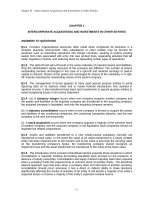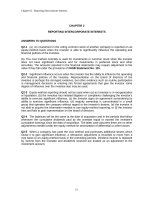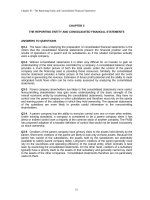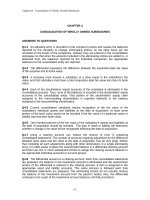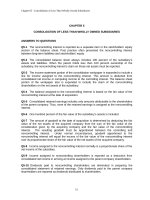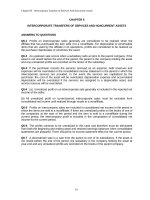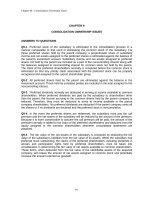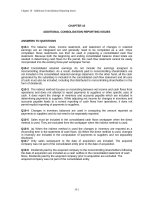Solution manual mechanics of materials 8th edition hibbeler chapter 13
Bạn đang xem bản rút gọn của tài liệu. Xem và tải ngay bản đầy đủ của tài liệu tại đây (7.22 MB, 121 trang )
13 Solutions 46060
6/11/10
11:56 AM
Page 1038
© 2010 Pearson Education, Inc., Upper Saddle River, NJ. All rights reserved. This material is protected under all copyright laws as they currently
exist. No portion of this material may be reproduced, in any form or by any means, without permission in writing from the publisher.
•13–1.
Determine the critical buckling load for the column.
The material can be assumed rigid.
P
L
2
k
Equilibrium: The disturbing force F can be determined by summing moments
about point A.
a + ©MA = 0;
P(Lu) - F a
L
b = 0
2
A
F = 2Pu
Spring Formula: The restoring spring force F1 can be determine using spring
formula Fs = kx.
Fs = ka
L
kLu
ub =
2
2
Critical Buckling Load: For the mechanism to be on the verge of buckling, the
disturbing force F must be equal to the restoring spring force F1.
2Pcr u =
Pcr =
L
2
kLu
2
kL
4
Ans.
1038
13 Solutions 46060
6/11/10
11:56 AM
Page 1039
© 2010 Pearson Education, Inc., Upper Saddle River, NJ. All rights reserved. This material is protected under all copyright laws as they currently
exist. No portion of this material may be reproduced, in any form or by any means, without permission in writing from the publisher.
13–2. Determine the critical load Pcr for the rigid bar and
spring system. Each spring has a stiffness k.
P
Equilibrium: The disturbing forces F1 and F2 can be related to P by writing the
moment equation of equlibrium about point A. Using small angle ananlysis, where
cos u Х 1 and sin u = u,
+ ©MA = 0;
F2 a
L
3
k
L
2
b + F1 a Lb - PLu = 01
3
3
L
3
F2 + 2F1 = 3Pu
k
(1)
Spring Force. The restoring spring force A Fsp B 1 and A Fsp B 2 can be determined using
the spring formula,
2
1
Lu and x2 = Lu, Fig. b. Thus,
3
3
2
2
= kx1 = ka Lu b = kLu
3
3
L
3
A
Fsp = kx, where x1 =
A Fsp B 1
A Fsp B 2 = kx2 = ka Lu b =
1
3
Critical Buckling Load. When the mechanism is on the verge of buckling the
disturbing force F must be equal to the restoring force of the spring Fsp. Thus,
F1 = A Fsp B 1 =
2
kLu
3
F2 = A Fsp B 2 =
1
kLu
3
Substituting this result into Eq. (1),
2
1
kLu + 2 a kLu b = 3Pcr u
3
3
Pcr =
5
kL
9
Ans.
1039
1
kLu
3
13 Solutions 46060
6/11/10
11:56 AM
Page 1040
© 2010 Pearson Education, Inc., Upper Saddle River, NJ. All rights reserved. This material is protected under all copyright laws as they currently
exist. No portion of this material may be reproduced, in any form or by any means, without permission in writing from the publisher.
13–3. The leg in (a) acts as a column and can be modeled
(b) by the two pin-connected members that are attached to a
torsional spring having a stiffness k (torque͞rad). Determine
the critical buckling load. Assume the bone material is rigid.
a + ©MA = 0;
-P(u)a
P
L
b + 2ku = 0
2
L
—
2
Require:
k
Pcr =
4k
L
Ans.
L
—
2
(a)
*13–4. Rigid bars AB and BC are pin connected at B. If
the spring at D has a stiffness k, determine the critical load
Pcr for the system.
(b)
P
A
Equilibrium. The disturbing force F can be related P by considering the equilibrium
of joint A and then the equilibrium of member BC,
a
B
Joint A (Fig. b)
+ c ©Fy = 0;
FAB cos f - P = 0
FAB =
a
P
cos f
k
D
Member BC (Fig. c)
a
©MC = 0; F(a cos u) -
P
P
cos f (2a sin u) sin f(2a cos u) = 0
cos f
cos f
C
F = 2P(tan u + tan f)
Since u and f are small, tan u Х u and tan f Х f. Thus,
F = 2P(u + f)
(1)
Also, from the geometry shown in Fig. a,
2au = af
f = 2u
Thus Eq. (1) becomes
F = 2P(u + 2u) = 6Pu
Spring Force. The restoring spring force Fsp can be determined using the spring
formula, Fsp = kx, where x = au, Fig. a. Thus,
Fsp = kx = kau
1040
13 Solutions 46060
6/11/10
11:56 AM
Page 1041
© 2010 Pearson Education, Inc., Upper Saddle River, NJ. All rights reserved. This material is protected under all copyright laws as they currently
exist. No portion of this material may be reproduced, in any form or by any means, without permission in writing from the publisher.
13–4.
Continued
Critical Buckling Load. When the mechanism is on the verge of buckling the
disturbing force F must be equal to the restoring spring force Fsp.
F = Fsp
6Pcru = kau
Pcr =
ka
6
Ans.
1041
13 Solutions 46060
6/11/10
11:56 AM
Page 1042
© 2010 Pearson Education, Inc., Upper Saddle River, NJ. All rights reserved. This material is protected under all copyright laws as they currently
exist. No portion of this material may be reproduced, in any form or by any means, without permission in writing from the publisher.
•13–5.
An A-36 steel column has a length of 4 m and is
pinned at both ends. If the cross sectional area has the
dimensions shown, determine the critical load.
25 mm
Section Properties:
A = 0.01(0.06) + 0..05(0.01) = 1.10 A 10 - 3 B m2
Ix = Iy =
10 mm
1
1
(0.01) A 0.063 B +
(0.05) A 0.013 B = 0.184167 A 10 - 6 B m4
12
12
25 mm
Critical Buckling Load: K = 1 for pin supported ends column. Applying Euler’s
formula,
Pcr =
25 mm
25 mm
10 mm
p2EI
(KL)2
p2 (200)(109)(0.184167)(10 - 6)
=
[1(4)]2
Ans.
= 22720.65 N = 22.7 kN
Critical Stress: Euler’s formula is only valid if scr 6 sg.
scr =
Pcr
22720.65
= 20.66 MPa 6 sg = 250 MPa
=
A
1.10(10 - 3)
O.K.
13–6. Solve Prob. 13–5 if the column is fixed at its bottom
and pinned at its top.
25 mm
Section Properties:
A = 0.01(0.06) + 0.05(0.01) = 1.10 A 10 - 3 B m2
10 mm
1
1
Ix = Iy =
(0.01) A 0.063 B +
(0.05) A 0.013 B = 0.184167 A 10 - 6 B m4
12
12
25 mm
Critical Buckling Load: K = 0.7 for one end fixed and the other end pinned
column. Applying Euler’s formula,
Pcr =
p EI
(EL)2
p2 (200)(109)(0.184167)(10 - 6)
=
[0.7(4)]2
Ans.
= 46368.68 N = 46.4 kN
Critical Stress: Euler’s formula is only valid if scr 6 sg.
scr =
25 mm
25 mm
10 mm
2
Pcr
46368.68
= 42.15 MPa 6 sg = 250 MPa
=
A
1.10(10 - 3)
1042
O.K.
13 Solutions 46060
6/11/10
11:56 AM
Page 1043
© 2010 Pearson Education, Inc., Upper Saddle River, NJ. All rights reserved. This material is protected under all copyright laws as they currently
exist. No portion of this material may be reproduced, in any form or by any means, without permission in writing from the publisher.
13–7. A column is made of A-36 steel, has a length of 20 ft,
and is pinned at both ends. If the cross-sectional area has
the dimensions shown, determine the critical load.
6 in.
0.25 in.
The cross sectional area and moment of inertia of the square tube is
5.5 in.
A = 6(6) - 5.5(5.5) = 5.75 in2
I =
0.25 in.
1
1
(6)(63) (5.5)(5.53) = 31.74 in4
12
12
0.25 in.
0.25 in.
The column is pinned at both of its end, k = 1. For A36 steel, E = 29.0(103) ksi and
sg = 36 ksi (table in appendix). Applying Euler’s formula,
Pcr =
p2 C 29.0(103) D (31.74)
p2EI
=
(KL)2
C 1(20)(12) D 2
Ans.
= 157.74 kip = 158
Critical Stress. Euler’s formula is valid only if scr 6 sg.
scr =
Pcr
157.74
=
= 27.4 ksi 6 sg = 36 ksi
A
5.75
O.K.
*13–8. A column is made of 2014-T6 aluminum, has a
length of 30 ft, and is fixed at its bottom and pinned at its
top. If the cross-sectional area has the dimensions shown,
determine the critical load.
6 in.
0.25 in.
5.5 in.
The cross-sectional area and moment of inertia of the square tube is
0.25 in.
A = 6(6) - 5.5(5.5) = 5.75 in2
0.25 in.
1
1
I =
(6)(63) (5.5)(5.53) = 31.74 in4
12
12
The column is fixed at one end, K = 0.7. For 2014–76 aluminium, E = 10.6(103) ksi
and sg = 60 ksi (table in appendix). Applying Euler’s formula,
Pcr =
p2 C 10.6(103) D (31.74)
p2EI
=
(KL)2
C 0.7(30)(12) D 2
Ans.
= 52.29 kip = 52.3 kip
Critical Stress. Euler’s formula is valid only if scr 6 sg.
scr =
Pcr
52.3
=
= 9.10 ksi 6 sg = 60 ksi
A
5.75
O.K.
1043
0.25 in.
13 Solutions 46060
6/11/10
11:56 AM
Page 1044
© 2010 Pearson Education, Inc., Upper Saddle River, NJ. All rights reserved. This material is protected under all copyright laws as they currently
exist. No portion of this material may be reproduced, in any form or by any means, without permission in writing from the publisher.
•13–9.
The W14 * 38 column is made of A-36 steel and is
fixed supported at its base. If it is subjected to an axial load
of P = 15 kip, determine the factor of safety with respect to
buckling.
P
From the table in appendix, the cross-sectional area and moment of inertia about
weak axis (y-axis) for W14 * 38 are
20 ft
A = 11.2 in2
Iy = 26.7 in4
The column is fixed at its base and free at top, k = 2. Here, the column will buckle
about the weak axis (y axis). For A36 steel, E = 29.0(103) ksi and sy = 36 ksi.
Applying Euler’s formula,
p2 C 29.0(103) D (26.7)
p2EIy
Pcr =
C 2 (20)(12) D 2
=
(KL)2
= 33.17 kip
Thus, the factor of safety with respect to buckling is
F.S =
Pcr
33.17
=
= 2.21
P
15
Ans.
The Euler’s formula is valid only if scr 6 sg.
scr =
Pcr
33.17
=
= 2.96 ksi 6 sg = 36 ksi
A
11.2
O.K.
13–10. The W14 * 38 column is made of A-36 steel.
Determine the critical load if its bottom end is fixed
supported and its top is free to move about the strong axis
and is pinned about the weak axis.
P
From the table in appendix, the cross-sectional area and moment of inertia about
weak axis (y-axis) for W14 * 38 are
A = 11.2 in2
Ix = 385 in4
Iy = 26.7 in4
The column is fixed at its base and free at top about strong axis. Thus, kx = 2. For
A36 steel, E = 29.0(103) ksi and sg = 36 ksi.
Pcr =
p2EIx
(KxLx)
2
=
p2 C 29.0(103) D (385)
C 2 (20)(12) D 2
= 478.28 kip
The column is fixed at its base and pinned at top about weak axis. Thus, ky = 0.7.
Pcr =
p2EIy
2
(KyLy)
=
p2 C 29.0(103) D (26.7)
C 0.7(20)(12) D 2
Ans.
= 270.76 kip = 271 kip (Control)
The Euler’s formula is valid only if scr 6 sg.
scr =
Pcr
270.76
=
= 24.17 ksi 6 sg = 36 ksi
A
11.2
O.K.
1044
20 ft
13 Solutions 46060
6/11/10
11:56 AM
Page 1045
© 2010 Pearson Education, Inc., Upper Saddle River, NJ. All rights reserved. This material is protected under all copyright laws as they currently
exist. No portion of this material may be reproduced, in any form or by any means, without permission in writing from the publisher.
13–11. The A-36 steel angle has a cross-sectional area of
A = 2.48 in2 and a radius of gyration about the x axis of
rx = 1.26 in. and about the y axis of ry = 0.879 in. The
smallest radius of gyration occurs about the z axis and is
rz = 0.644 in. If the angle is to be used as a pin-connected
10-ft-long column, determine the largest axial load that can
be applied through its centroid C without causing it to buckle.
y
z
C
x
x
z
y
The least radius of gyration:
r2 = 0.644 in.
scr =
p2E
2
A KL
r B
controls.
K = 1.0
;
p2 (29)(103)
(120) 2
C 1.00.644
D
=
= 8.243 ksi 6 sg
O.K.
Pcr = scr A = 8.243 (2.48) = 20.4 kip
Ans.
*13–12. An A-36 steel column has a length of 15 ft and is
pinned at both ends. If the cross-sectional area has the
dimensions shown, determine the critical load.
8 in.
0.5 in.
0.5 in.
6 in.
0.5 in.
Ix =
1
1
(8)(73) (7.5)(63) = 93.67 in4
12
12
Iy = 2 a
Pcr =
1
1
b(0.5)(83) +
(6)(0.53) = 42.729 in4 (controls)
12
12
p2(29)(103)(42.729)
p2EI
=
2
(EL)
[(1.0)(15)(12)]2
= 377 kip
Ans.
Check:
A = (2)(8)(0.5) + 6(0.5) = 11 in2
scr =
Pcr
377
=
= 34.3 ksi 6 sg
A
11
Therefore, Euler’s formula is valid
1045
13 Solutions 46060
6/11/10
11:56 AM
Page 1046
© 2010 Pearson Education, Inc., Upper Saddle River, NJ. All rights reserved. This material is protected under all copyright laws as they currently
exist. No portion of this material may be reproduced, in any form or by any means, without permission in writing from the publisher.
•13–13.
An A-36 steel column has a length of 5 m and is
fixed at both ends. If the cross-sectional area has the
dimensions shown, determine the critical load.
I =
10 mm
10 mm
50 mm
1
1
(0.1)(0.053) (0.08)(0.033) = 0.86167 (10 - 6) m4
12
12
Pcr =
100 mm
p2(200)(109)(0.86167)(10 - 6)
p2EI
=
2
(KL)
[(0.5)(5)]2
= 272 138 N
= 272 kN
scr =
=
Pcr
;
A
Ans.
A = (0.1)(0.05) - (0.08)(0.03) = 2.6(10 - 3) m2
272 138
= 105 MPa 6 sg
2.6 (10 - 3)
Therefore, Euler’s formula is valid.
13–14. The two steel channels are to be laced together
to form a 30-ft-long bridge column assumed to be pin
connected at its ends. Each channel has a cross-sectional
area of A = 3.10 in2 and moments of inertia Ix = 55.4 in4,
Iy = 0.382 in4. The centroid C of its area is located in
the figure. Determine the proper distance d between the
centroids of the channels so that buckling occurs about the
x–x and y¿ – y¿ axes due to the same load. What is the value
of this critical load? Neglect the effect of the lacing.
Est = 2911032 ksi, sY = 50 ksi.
y
0.269 in.
C
d
y
In order for the column to buckle about x - x and y - y at the same time, Iy must
be equal to Ix
Iy = Ix
0.764 + 1.55 d2 = 110.8
d = 8.43 in.
Ans.
Check:
d 7 2(1.231) = 2.462 in.
O.K.
3
p (29)(10 )(110.8)
p2 EI
=
2
(KL)
[1.0(360)]2
= 245 kip
Ans.
Check stress:
scr =
x
C
d 2
Iy = 2(0.382) + 2 (3.10)a b = 0.764 + 1.55 d2
2
Pcr =
1.231 in.
x
Ix = 2(55.4) = 110.8 in.4
2
y¿
Pcr
245
=
= 39.5 ksi 6 sg
A
2(3.10)
Therefore, Euler’s formula is valid.
1046
y¿
13 Solutions 46060
6/11/10
11:56 AM
Page 1047
© 2010 Pearson Education, Inc., Upper Saddle River, NJ. All rights reserved. This material is protected under all copyright laws as they currently
exist. No portion of this material may be reproduced, in any form or by any means, without permission in writing from the publisher.
13–15. An A-36-steel W8 * 24 column is fixed at one end
and free at its other end. If it is subjected to an axial load
of 20 kip, determine the maximum allowable length of the
column if F.S. = 2 against buckling is desired.
Section Properties. From the table listed in the appendix, the cross-sectional area
and moment of inertia about the y axis for a W8 * 24 are
A = 7.08 in2
Iy = 18.3 in4
Critical Buckling Load. The critical buckling load is
Pcr = Pallow (F.S) = 20(2) = 40 kip
Applying Euler’s formula,
p2 EIy
Pcr =
40 =
(KL)2
p2 C 29 A 103 B D (18.3)
(2L)2
L = 180.93 in = 15.08 ft = 15.1 ft
Ans.
Critical Stress. Euler’s formula is valid only if scr 6 sY.
scr =
Pcr
40
=
= 5.65 ksi 6 sY = 36 ksi
A
7.08
O.K.
*13–16. An A-36-steel W8 * 24 column is fixed at one
end and pinned at the other end. If it is subjected to an axial
load of 60 kip, determine the maximum allowable length of
the column if F.S. = 2 against buckling is desired.
Section Properties. From the table listed in the appendix, the cross-sectional area
and moment of inertia about the y axis for a W8 * 24 are
A = 7.08 in2
Iy = 18.3 in4
Critical Buckling Load. The critical buckling load is
Pcr = Pallow (F.S.) = 60(2) = 120 kip
Applying Euler’s formula,
Pcr =
120 =
p2EIy
(KL)2
p2 C 24 A 103 B D (18.3)
(0.7L)2
L = 298.46 in = 24.87 ft = 24.9 ft
Ans.
Critical Stress. Euler’s formula is valid only if scr 6 sY.
scr =
Pcr
120
=
= 16.95 ksi 6 sY = 36 ksi
A
7.08
O.K.
1047
13 Solutions 46060
6/11/10
11:56 AM
Page 1048
© 2010 Pearson Education, Inc., Upper Saddle River, NJ. All rights reserved. This material is protected under all copyright laws as they currently
exist. No portion of this material may be reproduced, in any form or by any means, without permission in writing from the publisher.
•13–17.
The 10-ft wooden rectangular column has the
dimensions shown. Determine the critical load if the ends
are assumed to be pin connected. Ew = 1.611032 ksi,
sY = 5 ksi.
Section Properties:
10 ft
A = 4(2) = 8.00 in2
4 in.
Ix =
1
(2) A 43 B = 10.667 in4
12
Iy =
1
(4) A 23 B = 2.6667 in4 (Controls !)
12
2 in.
Critical Buckling Load: K = 1 for pin supported ends column. Applying Euler’s
formula,.
Pcr =
p2EI
(KL)2
p2(1.6)(103)(2.6667)
=
[1(10)(12)]2
Ans.
= 2.924 kip = 2.92 kip
Critical Stress: Euler’s formula is only valid if scr 6 sg.
scr =
Pcr
2.924
=
= 0.3655 ksi 6 sg = 5 ksi
A
8.00
O.K.
13–18. The 10-ft column has the dimensions shown.
Determine the critical load if the bottom is fixed and the
top is pinned. Ew = 1.611032 ksi, sY = 5 ksi.
Section Properties:
A = 4(2) = 8.00 in2
10 ft
1
(2) A 43 B = 10.667 in4
Ix =
12
4 in.
2 in.
1
Iy =
(4) A 23 B = 2.6667 in4 (Controls!)
12
Critical Buckling Load: K = 0.7 for column with one end fixed and the other end
pinned. Applying Euler’s formula.
Pcr =
p2EI
(KL)2
p2 (1.6)(103)(2.6667)
=
[0.7(10)(12)]2
Ans.
= 5.968 kip = 5.97 kip
Critical Stress: Euler’s formula is only valid if scr 6 sg.
scr =
Pcr
5.968
=
= 0.7460 ksi 6 sg = 5 ksi
A
8.00
O.K.
1048
13 Solutions 46060
6/11/10
11:56 AM
Page 1049
© 2010 Pearson Education, Inc., Upper Saddle River, NJ. All rights reserved. This material is protected under all copyright laws as they currently
exist. No portion of this material may be reproduced, in any form or by any means, without permission in writing from the publisher.
13–19. Determine the maximum force P that can be
applied to the handle so that the A-36 steel control rod BC
does not buckle. The rod has a diameter of 25 mm.
P
350 mm
A
250 mm
45Њ
Support Reactions:
a + ©MA = 0;
P(0.35) - FBC sin 45°(0.25) = 0
FBC = 1.9799P
Section Properties:
A =
p
A 0.0252 B = 0.15625 A 10 - 3 B p m2
4
I =
p
A 0.01254 B = 19.17476 A 10 - 9 B m4
4
Critical Buckling Load: K = 1 for a column with both ends pinned. Appyling
Euler’s formula,
Pcr = FBC =
1.9799P =
p2EI
(KLBC)2
p2(200)(109) C 19.17476(10 - 9) D
[1(0.8)]2
P = 29 870 N = 29.9 kN
Ans.
Critical Stress: Euler’s formula is only valid if scr 6 sg.
scr =
1.9799(29 870)
Pcr
= 120.5 MPa 6 sg = 250 MPa
=
A
0.15625(10 - 3)p
1049
O.K.
C
B
800 mm
13 Solutions 46060
6/11/10
11:56 AM
Page 1050
© 2010 Pearson Education, Inc., Upper Saddle River, NJ. All rights reserved. This material is protected under all copyright laws as they currently
exist. No portion of this material may be reproduced, in any form or by any means, without permission in writing from the publisher.
*13–20. The W10 * 45 is made of A-36 steel and is used
as a column that has a length of 15 ft. If its ends are assumed
pin supported, and it is subjected to an axial load of 100 kip,
determine the factor of safety with respect to buckling.
P
Critical Buckling Load: Iy = 53.4 in4 for a W10 * 45 wide flange section and
K = 1 for pin supported ends column. Applying Euler’s formula,
Pcr =
15 ft
p2EI
(KL)2
p2 (29)(103)(53.4)
=
[1(15)(12)]2
P
= 471.73 kip
Critical Stress: Euler’s formula is only valid if scr 6 sg. A = 13.3 in2 for the
W10 * 45 wide-flange section.
scr =
Pcr
471.73
=
= 35.47 ksi 6 sg = 36 ksi
A
13.3
O.K.
Pcr
471.73
=
= 4.72
P
100
Ans.
Factor of Safety:
F.S =
The W10 * 45 is made of A-36 steel and is used
as a column that has a length of 15 ft. If the ends of the
column are fixed supported, can the column support the
critical load without yielding?
•13–21.
P
Critical Buckling Load: Iy = 53.4 in4 for W10 * 45 wide flange section and
K = 0.5 for fixed ends support column. Applying Euler’s formula,
Pcr =
15 ft
p2EI
(KL)2
p2 (29)(103)(53.4)
=
[0.5(15)(12)]2
P
= 1886.92 kip
Critical Stress: Euler’s formula is only valid if scr 6 sg. A = 13.3 in2 for W10 * 45
wide flange section.
scr =
Pcr
1886.92
=
= 141.87 ksi 7 sg = 36 ksi (No!)
A
13.3
Ans.
The column will yield before the axial force achieves the critical load Pcr and so
Euler’s formula is not valid.
1050
13 Solutions 46060
6/11/10
11:56 AM
Page 1051
© 2010 Pearson Education, Inc., Upper Saddle River, NJ. All rights reserved. This material is protected under all copyright laws as they currently
exist. No portion of this material may be reproduced, in any form or by any means, without permission in writing from the publisher.
13–22. The W12 * 87 structural A-36 steel column has a
length of 12 ft. If its bottom end is fixed supported while
its top is free, and it is subjected to an axial load of
P = 380 kip, determine the factor of safety with respect to
buckling.
W 12 * 87
A = 25.6 in2
Ix = 740 in4
P
Iy = 241 in4 (controls)
12 ft
K = 2.0
Pcr =
p2(29)(103)(241)
p2EI
=
= 831.63 kip
2
(KL)
[(2.0)(12)(12)]2
Pcr
831.63
=
= 2.19
P
380
F.S. =
Ans.
Check:
scr =
=
Pcr
A
831.63
= 32.5 ksi 6 sg
25.6
O.K.
13–23. The W12 * 87 structural A-36 steel column has a
length of 12 ft. If its bottom end is fixed supported while its
top is free, determine the largest axial load it can support.
Use a factor of safety with respect to buckling of 1.75.
W 12 * 87
A = 25.6 in2
Ix = 740 in4
P
Iy = 241 in4
(controls)
K = 2.0
12 ft
Pcr
p2(29)(103)(241)
p2EI
=
=
= 831.63 kip
2
(KL)
(2.0(12)(12))2
P =
Pcr
831.63
=
= 475 ksi
F.S
1.75
Ans.
Check:
scr =
P
831.63
=
= 32.5 ksi 6 sg
A
25.6
O.K.
1051
13 Solutions 46060
6/11/10
11:56 AM
Page 1052
© 2010 Pearson Education, Inc., Upper Saddle River, NJ. All rights reserved. This material is protected under all copyright laws as they currently
exist. No portion of this material may be reproduced, in any form or by any means, without permission in writing from the publisher.
*13–24. An L-2 tool steel link in a forging machine is pin
connected to the forks at its ends as shown. Determine the
maximum load P it can carry without buckling. Use a factor
of safety with respect to buckling of F.S. = 1.75. Note from
the figure on the left that the ends are pinned for buckling,
whereas from the figure on the right the ends are fixed.
P
P
1.5 in.
0.5 in.
24 in.
Section Properties:
A = 1.5(0.5) = 0.750 in2
Ix =
1
(0.5) A 1.53 B = 0.140625 in4
12
Iy =
1
(1.5) A 0.53 B = 0.015625 in4
12
P
Critical Buckling Load: With respect to the x - x axis, K = 1 (column with both
ends pinned). Applying Euler’s formula,
Pcr =
p2EI
(KL)2
p2(29.0)(103)(0.140625)
=
[1(24)]2
= 69.88 kip
With respect to the y - y axis, K = 0.5 (column with both ends fixed).
Pcr =
p2EI
(KL)2
p2(29.0)(103)(0.015625)
=
[0.5(24)]2
= 31.06 kip
(Controls!)
Critical Stress: Euler’s formula is only valid if scr 6 sg.
scr =
Pcr
31.06
=
= 41.41 ksi 6 sg = 102 ksi
A
0.75
O.K.
Factor of Safety:
F.S =
1.75 =
Pcr
P
31.06
P
P = 17.7 kip
Ans.
1052
P
13 Solutions 46060
6/11/10
11:56 AM
Page 1053
© 2010 Pearson Education, Inc., Upper Saddle River, NJ. All rights reserved. This material is protected under all copyright laws as they currently
exist. No portion of this material may be reproduced, in any form or by any means, without permission in writing from the publisher.
The W14 * 30 is used as a structural A-36 steel
column that can be assumed pinned at both of its ends.
Determine the largest axial force P that can be applied
without causing it to buckle.
•13–25.
P
From the table in appendix, the cross-sectional area and the moment of inertia
about weak axis (y-axis) for W14 * 30 are
A = 8.85 in2
Iy = 19.6 in4
25 ft
Critical Buckling Load: Since the column is pinned at its base and top, K = 1. For
A36 steel, E = 29.0(103) ksi and sg = 36 ksi. Here, the buckling occurs about the
weak axis (y-axis).
P = Pcr =
p2EIy
(KL)2
=
p2 C 29.0(103) D (19.6)
C 1(25)(12) D 2
Ans.
= 62.33 kip = 62.3 kip
Euler’s formula is valid only if scr 6 sg.
scr =
Pcr
62.33
=
= 7.04 ksi 6 sg = 36 ksi
A
8.85
O.K.
13–26. The A-36 steel bar AB has a square cross section.
If it is pin connected at its ends, determine the maximum
allowable load P that can be applied to the frame. Use a
factor of safety with respect to buckling of 2.
a + ©MA = 0;
C
FBC sin 30°(10) - P(10) = 0
FBC = 2 P
+
: ©Fx = 0;
A
1.5 in.
30Њ
B
1.5 in.
FA - 2P cos 30° = 0
1.5 in.
10 ft
FA = 1.732 P
P
Buckling load:
Pcr = FA(F.S.) = 1.732 P(2) = 3.464 P
L = 10(12) = 120 in.
I =
1
(1.5)(1.5)3 = 0.421875 in4
12
Pcr =
p2 EI
(KL)2
3.464 P =
p2 (29)(103)(0.421875)
[(1.0)(120)]2
P = 2.42 kip
Ans.
Pcr = FA(F.S.) = 1.732(2.42)(2) = 8.38 kip
Check:
scr =
Pcr
8.38
=
= 3.72 ksi 6 sg
A
1.5 (1.5)
O.K.
1053
13 Solutions 46060
6/11/10
11:56 AM
Page 1054
© 2010 Pearson Education, Inc., Upper Saddle River, NJ. All rights reserved. This material is protected under all copyright laws as they currently
exist. No portion of this material may be reproduced, in any form or by any means, without permission in writing from the publisher.
13–27. Determine the maximum allowable intensity w of
the distributed load that can be applied to member BC
without causing member AB to buckle. Assume that AB is
made of steel and is pinned at its ends for x–x axis buckling
and fixed at its ends for y–y axis buckling. Use a factor
of safety with respect to buckling of 3. Est = 200 GPa,
sY = 360 MPa.
w
C
1.5 m
B
0.5 m
2m
30 mm
x
Ix =
1
(0.02)(0.033) = 45.0(10 - 9)m4
12
Iy =
1
(0.03)(0.023) = 20(10 - 9) m4
12
x
x-x axis:
Pcr = FAB (F.S.) = 1.333w(3) = 4.0 w
K = 1.0,
Pcr =
L = 2m
p2EI
(KL)2
4.0w =
p2(200)(109)(45.0)(10 - 9)
[(1.0)(2)]2
w = 5552 N>m = 5.55 kN>m
Ans.
(controls)
y-y axis
K = 0.5,
4.0w =
L = 2m
p2 (200)(109)(20)(10 - 9)
[(0.5)(2)]2
w = 9870 N>m = 9.87 kN>m
Check:
scr =
20 mm
y
y
Moment of inertia:
4(5552)
Pcr
=
= 37.0 MPa 6 sg
A
(0.02)(0.03)
O.K.
1054
30 mm
A
13 Solutions 46060
6/11/10
11:56 AM
Page 1055
© 2010 Pearson Education, Inc., Upper Saddle River, NJ. All rights reserved. This material is protected under all copyright laws as they currently
exist. No portion of this material may be reproduced, in any form or by any means, without permission in writing from the publisher.
*13–28. Determine if the frame can support a load of
w = 6 kN>m if the factor of safety with respect to buckling
of member AB is 3. Assume that AB is made of steel and is
pinned at its ends for x–x axis buckling and fixed at its ends
for y–y axis buckling. Est = 200 GPa, sY = 360 MPa.
w
C
B
1.5 m
0.5 m
Check x-x axis buckling:
Ix =
1
(0.02)(0.03)3 = 45.0(10 - 9) m4
12
K = 1.0
Pcr
2m
30 mm
x
20 mm
y
y
L = 2m
p2(200)(109)(45.0)(10 - 9)
p2EI
=
=
2
(KL)
((1.0)(2))2
x
A
30 mm
Pcr = 22.2 kN
a + ©MC = 0;
FAB(1.5) - 6(2)(1) = 0
FAB = 8 kN
Preq’d = 8(3) = 24 kN 7 22.2 kN
No, AB will fail.
Ans.
The beam supports the load of P = 6 kip. As a
result, the A-36 steel member BC is subjected to a
compressive load. Due to the forked ends on the member,
consider the supports at B and C to act as pins for x–x axis
buckling and as fixed supports for y–y axis buckling.
Determine the factor of safety with respect to buckling
about each of these axes.
•13–29.
a + ©MA = 0;
P
4 ft
A
3 ft
1
)(1)(3)3
p2(29)(103)(12
p2EI
=
= 178.9 kip
2
(KL)
(1.0(5)(12))2
178.9
= 8.94
20
Ans.
y-y axis buckling:
Pcr =
F.S. =
3 in.
y
x-x axis buckling:
F.S. =
B
C x
3
FBC a b(4) - 6000(8) = 0
5
FBC = 20 kip
Pcr =
4 ft
1
)(3)(1)3
p2 (29)(103)(12
p2EI
=
= 79.51
2
(KL)
(0.5(5)(12))2
79.51
= 3.98
20
Ans.
1055
1 in.
x
y
13 Solutions 46060
6/11/10
11:56 AM
Page 1056
© 2010 Pearson Education, Inc., Upper Saddle River, NJ. All rights reserved. This material is protected under all copyright laws as they currently
exist. No portion of this material may be reproduced, in any form or by any means, without permission in writing from the publisher.
13–30. Determine the greatest load P the frame will
support without causing the A-36 steel member BC to
buckle. Due to the forked ends on the member, consider the
supports at B and C to act as pins for x–x axis buckling and
as fixed supports for y–y axis buckling.
P
4 ft
A
3 ft
3
FBC a b(4) - P(8) = 0
5
a + ©MA = 0;
4 ft
B
y
3 in.
C x
1 in.
FBC = 3.33 P
y
x-x axis buckling:
Pcr =
x
1
)(1)(3)3
p2(29)(103)(12
p2EI
=
= 178.9 kip
(KL)2
(1.0(5)(12))2
y -y axis buckling:
Pcr =
1
)(3)(1)3
p2(29)(103)(12
p2EI
=
= 79.51 kip
(KL)2
(0.5(5)(12))2
Thus,
3.33 P = 79.51
P = 23.9 kip
Ans.
13–31. Determine the maximum distributed load that can
be applied to the bar so that the A-36 steel strut AB does
not buckle. The strut has a diameter of 2 in. It is pin
connected at its ends.
w
C
A
2 ft
The compressive force developed in member AB can be determined by writing the
moment equation of equilibrium about C.
a + ©MC = 0;
FAB(2) - w(2)(3) = 0
A = p(12) = p in2
I =
FAB = 3w
4 ft
p 4
p
(1 ) = in4
4
4
Since member AB is pinned at both ends, K = 1. For A36 steel, E = 29.0(103) ksi
and sg = 36 ksi.
Pcr =
p EI
;
(KL)2
p C 29.0(10 ) D (p>4)
2
2
3w =
3
C 1(4)(12) D 2
Ans.
w = 32.52 kip>ft = 32.5 kip>ft
The Euler’s formula is valid only if scr 6 sg.
scr =
3(32.52)
Pcr
=
= 31.06 ksi 6 sg = 36 ksi
p
A
O.K.
1056
B
2 ft
13 Solutions 46060
6/11/10
11:56 AM
Page 1057
© 2010 Pearson Education, Inc., Upper Saddle River, NJ. All rights reserved. This material is protected under all copyright laws as they currently
exist. No portion of this material may be reproduced, in any form or by any means, without permission in writing from the publisher.
*13–32. The members of the truss are assumed to be pin
connected. If member AC is an A-36 steel rod of 2 in.
diameter, determine the maximum load P that can be
supported by the truss without causing the member to buckle.
P
C
B
4 ft
D
A
3 ft
Section the truss through a-a, the FBD of the top cut segment is shown in Fig. a. The
compressive force developed in member AC can be determined directly by writing
the force equation of equilibrium along x axis.
+
: ©Fx = 0;
3
FAC a b - P = 0
5
A = p(12) = p in2
I =
FAC =
5
P (C)
3
p 4
p
(1 ) = in4
4
4
Since both ends of member AC are pinned, K = 1. For A-36 steel, E = 29.0(103) ksi
and sg = 36 ksi. The length of member AC is LAC = 232 + 42 = 5 ft.
Pcr =
p2EI
;
(KL)2
p2 C 29.0(103) D (p>4)
5
P =
3
C 1(5)(12) D 2
P = 37.47 kip = 37.5 kip
Ans.
Euler’s formula is valid only if scr 6 sg.
scr
5
(37.47)
Pcr
3
=
=
= 19.88 ksi 6 sg = 36 ksi
p
A
O.K.
1057
13 Solutions 46060
6/11/10
11:56 AM
Page 1058
© 2010 Pearson Education, Inc., Upper Saddle River, NJ. All rights reserved. This material is protected under all copyright laws as they currently
exist. No portion of this material may be reproduced, in any form or by any means, without permission in writing from the publisher.
•13–33.
The steel bar AB of the frame is assumed to be pin
connected at its ends for y–y axis buckling. If w = 3 kN>m,
determine the factor of safety with respect to buckling about
the y–y axis due to the applied loading. Est = 200 GPa,
sY = 360 MPa.
6m
w
B
C
40 mm
40 mm
3m
40 mm
y
x
A
4m
The force with reference to the FBD shown in Fig. a.
a + ©MC = 0;
3
3(6)(3) - FAB a b(6) = 0
5
A = 0.04(0.08) = 3.2(10 - 3) m2
Iy =
FAB = 15 kN
1
(0.08)(0.043) = 0.4267(10 - 6)m4
12
The length of member AB is L = 232 + 42 = 5m. Here, buckling will occur about
the weak axis, (y-axis). Since both ends of the member are pinned, Ky = 1.
Pcr =
p2EIy
(KyLy)2
=
p2 C 200(109) D C 0.4267(10 - 6) D
C 1.0(5) D 2
= 33.69 kN
Euler’s formula is valid only if scr 6 sg.
scr =
33.69(103)
Pcr
= 10.53(106)Pa = 10.53 MPa 6 sg = 360 MPa
=
A
3.2(10 - 3)
O.K.
Thus, the factor of safety against buckling is
F.S =
Pcr
33.69
=
= 2.25
FAB
15
Ans.
1058
13 Solutions 46060
6/11/10
11:56 AM
Page 1059
© 2010 Pearson Education, Inc., Upper Saddle River, NJ. All rights reserved. This material is protected under all copyright laws as they currently
exist. No portion of this material may be reproduced, in any form or by any means, without permission in writing from the publisher.
13–34. The members of the truss are assumed to be pin
connected. If member AB is an A-36 steel rod of 40 mm
diameter, determine the maximum force P that can be
supported by the truss without causing the member to buckle.
2m
C
E
D
1.5 m
B
A
2m
P
By inspecting the equilibrium of joint E, FAB = 0. Then, the compressive force
developed in member AB can be determined by analysing the equilibrium of joint
A, Fig. a.
+ c ©Fy = 0;
3
FAC a b - P = 0
5
+
: ©Fx = 0;
5
4
P a b - FAB = 0
3
5
A = p(0.022) = 0.4(10 - 3)p m2
I =
FAC =
5
P (T)
3
FAB =
4
P(c)
3
p
(0.024) = 40(10 - 9) p m4
4
Since both ends of member AB are pinned, K = 1. For A36 steel, E = 200 GPa and
sg = 250 MPa.
Pcr =
p2EI
;
(KL)2
p2 C 200(109) D C 40(10 - 9)p D
4
P =
3
C 1(2) D 2
P = 46.51(103) N = 46.5 kN
Ans.
The Euler’s formula is valid only if scr 6 sg.
scr
4
(46.51)(103)
Pcr
3
= 49.35(106) Pa = 49.35 MPa 6 sg = 250 MPa O.K.
=
=
A
0.4(10 - 3)p
1059
13 Solutions 46060
6/11/10
11:56 AM
Page 1060
© 2010 Pearson Education, Inc., Upper Saddle River, NJ. All rights reserved. This material is protected under all copyright laws as they currently
exist. No portion of this material may be reproduced, in any form or by any means, without permission in writing from the publisher.
13–35. The members of the truss are assumed to be pin
connected. If member CB is an A-36 steel rod of 40 mm
diameter, determine the maximum load P that can be
supported by the truss without causing the member to buckle.
2m
C
E
D
1.5 m
B
A
2m
P
Section the truss through a–a, the FBD of the left cut segment is shown in Fig. a. The
compressive force developed in member CB can be obtained directly by writing the
force equation of equilibrium along y axis.
+ c ©Fy = 0;
FCB - P = 0
A = p(0.022) = 0.4(10 - 3)p m2
FCB = P (C)
I =
p
(0.024) = 40(10 - 9)p m4
4
Since both ends of member CB are pinned, K = 1. For A36 steel, E = 200 GPa and
sg = 250 MPa.
Pcr =
p2EI
;
(KL)2
P =
p2 C 200(109) D C 40(10 - 9)p D
C 1(1.5) D 2
= 110.24(103) N = 110 kN
Ans.
The Euler’s formula is valid only if scr 6 sg.
scr =
110.24(103)
Pcr
= 87.73(106) Pa = 87.73 MPa 6 sg = 250 MPa
=
A
0.4(10 - 3)p
1060
O.K.
13 Solutions 46060
6/11/10
11:56 AM
Page 1061
© 2010 Pearson Education, Inc., Upper Saddle River, NJ. All rights reserved. This material is protected under all copyright laws as they currently
exist. No portion of this material may be reproduced, in any form or by any means, without permission in writing from the publisher.
*13–36. If load C has a mass of 500 kg, determine the
required minimum diameter of the solid L2-steel rod AB
to the nearest mm so that it will not buckle. Use F.S. = 2
against buckling.
A
45°
4m
D
Equilibriun. The compressive force developed in rod AB can be determined by
analyzing the equilibrium of joint A, Fig. a.
©Fy¿ = 0; FAB sin 15° - 500(9.81) cos 45° = 0
FAB = 13 400.71 N
Section Properties. The cross-sectional area and moment of inertia of the solid
rod are
A =
p 2
d
4
I =
p d 4
p 4
a b =
d
4 2
64
Critical Buckling Load. Since the rod is pinned at both of its ends, K = 1. Here,
Pcr = FAB (F.S.) = 13400.71(2) = 26801.42 N. Applying Euler’s formula,
Pcr =
p2EIy
(KL)2
26801.42 =
p2 C 200 A 109 B D c
p 4
d d
64
[1(4)]2
d = 0.04587 m = 45.87 mm
Use d = 46 mm
Ans.
Critical Stress. Euler’s formula is valid only if scr 6 sY.
scr =
Pcr
26801.42
=
= 16.13 MPa 6 sY = 703 MPa
p
A
2
A 0.046 B
4
1061
O.K.
60°
B
C
13 Solutions 46060
6/11/10
11:56 AM
Page 1062
© 2010 Pearson Education, Inc., Upper Saddle River, NJ. All rights reserved. This material is protected under all copyright laws as they currently
exist. No portion of this material may be reproduced, in any form or by any means, without permission in writing from the publisher.
•13–37. If the diameter of the solid L2-steel rod AB is
50 mm, determine the maximum mass C that the rod can
support without buckling. Use F.S. = 2 against buckling.
A
45°
4m
D
Equilibrium. The compressive force developed in rod AB can be determined by
analyzing the equilibrium of joint A, Fig. a.
©Fy¿ = 0; FAB sin 15° - m(9.81) cos 45° = 0
FAB = 26.8014m
B
Section Properties. The cross-sectional area and moment of inertia of the rod are
A =
I =
p
A 0.052 B = 0.625 A 10 - 3 B pm2
4
p
A 0.0254 B = 97.65625 A 10 - 9 B pm4
4
Critical Buckling Load. Since the rod is pinned at both of its ends, K = 1. Here,
Pcr = FAB (F.S.) = 26.8014m(2) = 53.6028m. Applying Euler’s formula,
Pcr =
p2EIy
(KL)2
53.6028m =
p2 c200 A 109 B d c97.65625 A 10 - 9 B p d
[1(4)]2
m = 706.11 kg = 7.06 kg
Ans.
Critical Stress. Euler’s formula is valid only if scr 6 sY.
scr =
53.6028(706.11)
Pcr
=
= 19.28 MPa 6 sY = 703 MPa
A
p 0.625 A 10 - 3 B
1062
60°
O.K.
C
